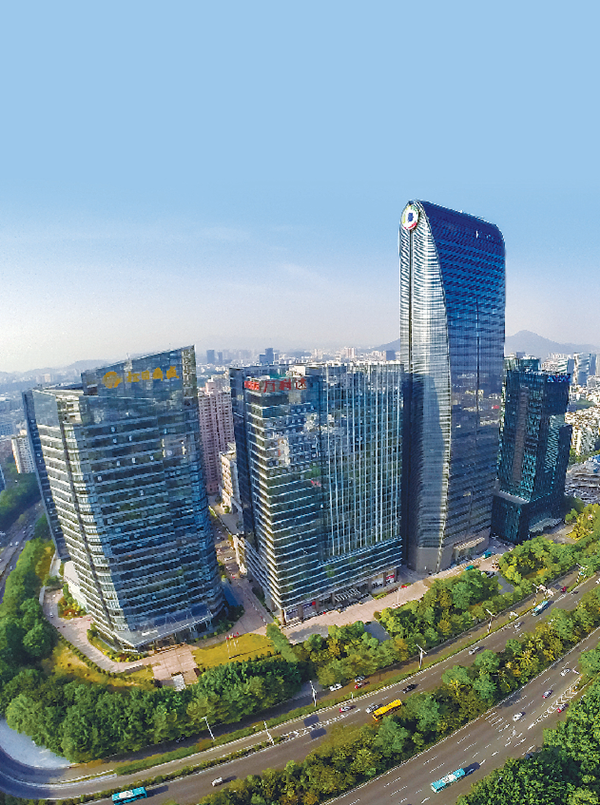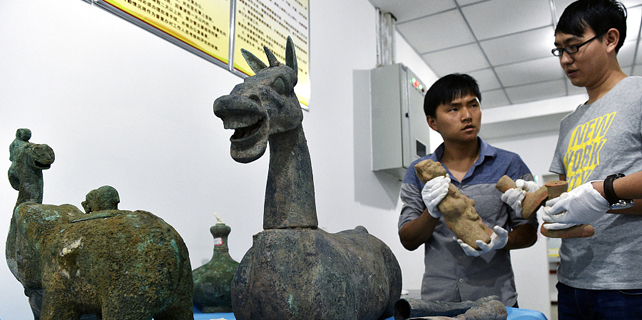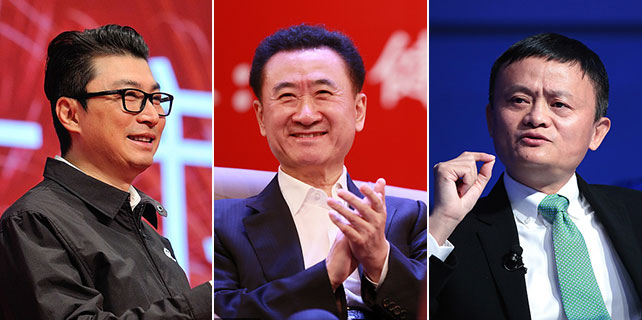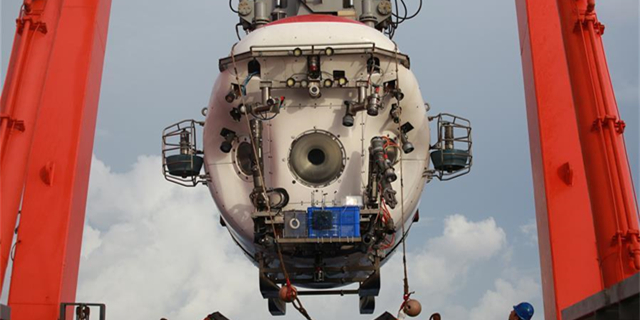Wired for growth
 |
|
The headquarters of Chinese internet giant Tencent (third left) in Shenzhen. The city has become a center of innovation. LIANG XIASHUN/IMAGINECHINA |
Shenzhen in South China draws on its strength as a production powerhouse to now rival Silicon Valley as a global tech innovator
Not so slowly, and certainly with little stealth, China's southern metropolis of Shenzhen has emerged as one of the most important centers of technological manufacturing.
The city now rivals California's Silicon Valley in the United States, on the other side of the planet, as a driver of innovation and growth.
Shenzhen was, until relatively recently, a sleepy fishing village across the border from the bustling financial center of Hong Kong. Then, it was given special economic zone status by paramount leader Deng Xiaoping in 1979.
It attracted manufacturers by the droves, and its infrastructure and population experienced one of the most rapid growths ever seen in history. In four decades, a market town of 30,000 people transformed itself into a metropolis of 18 million.
Shenzhen and the Greater Bay Area around it quickly grew to be a force in manufacturing and production. An estimated 90 percent of the world's consumer electronics are made in this area.
Meanwhile, the rise of personal computers and need for silicon chips attracted tech companies and venture capital firms to San Francisco Bay, giving rise to Silicon Valley.
"Shenzhen and Silicon Valley do share some similarities. They are both centers of innovation, both are a long way from their respective country's capitals, and attract a young labor force," Ben Simpfendorfer, founder and CEO of strategic advisory firm Silk Road Associates, told China Daily.
But there are also many key differences, the economist explained.
"Shenzhen still has a very specific role to play in the global tech industry, especially in manufacturing and telecommunications. It is still very much focused on the domestic market in China. Companies would be wise to choose it as a base if they want a gateway to China's tech market," Simpfendorfer said.
"Shenzhen is still very much on the hardware end of the tech industry. Beijing remains the software capital of the country, especially since most of the nation's top schools are located in the capital."
The southern city's location also gives it an advantage, said Ross O'Brien, managing director of advisory firm Intercedent Asia and an economist with decades of China experience.
"Shenzhen's location along the Pearl River Delta gives it access to the other cities in the economic zone there. One of the advantages of that is being able to tap into funding sources from places like Hong Kong," he said.
"Hong Kong's role is not to be minimized either. It has an important part to play as a neighbor in attracting the global talent pool needed while Shenzhen develops its infrastructure and facilities to be more enticing."
O'Brien, like Simpfendorfer, does not feel that Shenzhen and Silicon Valley are entirely comparable.
"It's not an exact copy of the same model," he said. "Silicon Valley has strong research and development, with talent from a lot of the top academic institutions. They also do a lot of incubation and funding of startups.
"In Shenzhen, they mostly build upon an existing idea and leverage on the production-oriented ecosystem."
One thing is certain, Shenzhen can draw on its strength as a production powerhouse to attract the tech industry to its corner of South China.
Despite being only a third of the geographic size of Shanghai and one-eighth that of Beijing, the GDP of the port city has grown faster. In the first half of 2016, Shenzhen led with 8.6 percent GDP growth compared to 6.7 percent for Beijing and Shanghai.
"Shenzhen accounted for 2.6 percent and 24.5 percent of the mainland economy and Guangdong province (the largest nationally) by nominal GDP in 2016, respectively," said Chua Han Teng, a senior Asia analyst at BMI Research.
He is optimistic about Shenzhen's future given its investment in research.
"The city's total R&D spending is high at 4 percent of GDP and the vibrant private sector will be the major driver of technological advancements and entrepreneurial activities," Chua said.
In 2016, Shenzhen's annual GDP totaled 1.93 trillion yuan ($280 billion). Shenzhen remains ambitious, setting a goal to grow its economy to 2.6 trillion yuan by 2020.
Judging by growth rates, the city could well be on its way. Its economy experienced 9 percent growth last year, surpassing the targeted 8 percent. The goal for 2017 is 8.5 percent.
"Shenzhen does offer many advantages," Simpfendorfer of Silk Road Associates said. "Given its roots in manufacturing, it is excellent at hardware supply. That makes it a great location for young companies, especially if they are looking for rapid prototype production in the development stages of their products. Shenzhen is also able to scale up the production pace quickly if demand follows. It's still a very nimble city."
These factors have all contributed to Shenzhen's impressively and aggressively fast expansion. But such growth comes with side effects that could hamper progress.
The real estate sector in Shenzhen has experienced the fastest growth in residential property prices compared to anywhere else in the world. Home prices have more than doubled since 2014 to above 50,000 yuan per square meter.
The authorities have clearly taken note of some of Shenzhen's property issues, such as cost and availability, and have already frozen sales in nearby cities to contain speculation.
The local authorities have also just received the first flush of funding, a $19 billion loan from the state-owned China Development Bank, to convert the northern farmland areas into a "green, livable and modern urban area".
Given the city's exposure to the latest advances in production technology, workers in Shenzhen come with considerable knowledge and training. O'Brien from Intercedent referred to this supply of human resources as a plus.
"Being at the point of an innovation sphere, Shenzhen has a semi-captive access to an incredible pool," he said.
That is not to say everything is smooth sailing for tech entrepreneurs in Shenzhen. There remain some challenges.
Trouble Maker is based in the city's Huaqiangbei district, which is also known as the world's largest electronics market. It offers companies and individuals an open platform to work from, with access to engineers who can help with product development, from prototyping and package design to mass production and distribution.
Henk Werner, CEO at Trouble Maker Shenzhen, said the city can be a daunting place for new tech entrepreneurs.
"Shenzhen attracts many people because it is the No 1 electronics market in the world. But it can be difficult to find your way around. Due to our lab's location and our years of experience here, we are able to help many people make the right connections," he said.
"Many people set up a company in Hong Kong and try to make it over here. But that's not legal. To work here, you need to set up a Chinese entity, which can be a drawn-out process that takes up to six months. Even getting a bank account can take up to two months. We can give advice on that."
Simpfendorfer echoed Werner's sentiments, saying that setting up a business can be complex.
"Tax rates are not as low as other places in the region and the cost of living is increasing rapidly," he said. "Even though (Shenzhen) is a very impressive city, it is still developing and may not offer enough attractive facilities, from schools to restaurants, to draw a more international workforce at the moment."
Rising property prices have also created some cause for concern. Shenzhen ranked as China's most expensive housing market, giving it an undesired similarity to the more expensive areas of Silicon Valley.
Furthermore, rival Silicon Valley has key factors that make it attractive to potential tech investors.
"Silicon Valley still has a more international workforce and pool of companies, which means it has access to both the domestic US market and the global market. Being a venture capital magnet, it also has easier access to capital than Shenzhen," he added.
Still, the unique geographic position of Shenzhen within the Greater Bay Area, and its access to finance in Hong Kong and manufacturing prowess in Guangzhou give it a significant leg up.
"If there is a good tech idea in China, it will most likely take off in Shenzhen, given the manufacturing muscle there," concluded O'Brien.
Trouble Maker's Werner agreed. "Silicon Valley may still be the No 1 startup city, but Shenzhen comes a close second and is tops for manufacturing," he said. "Ultimately, they focus on different parts: Silicon Valley for software, Shenzhen for hardware."
















